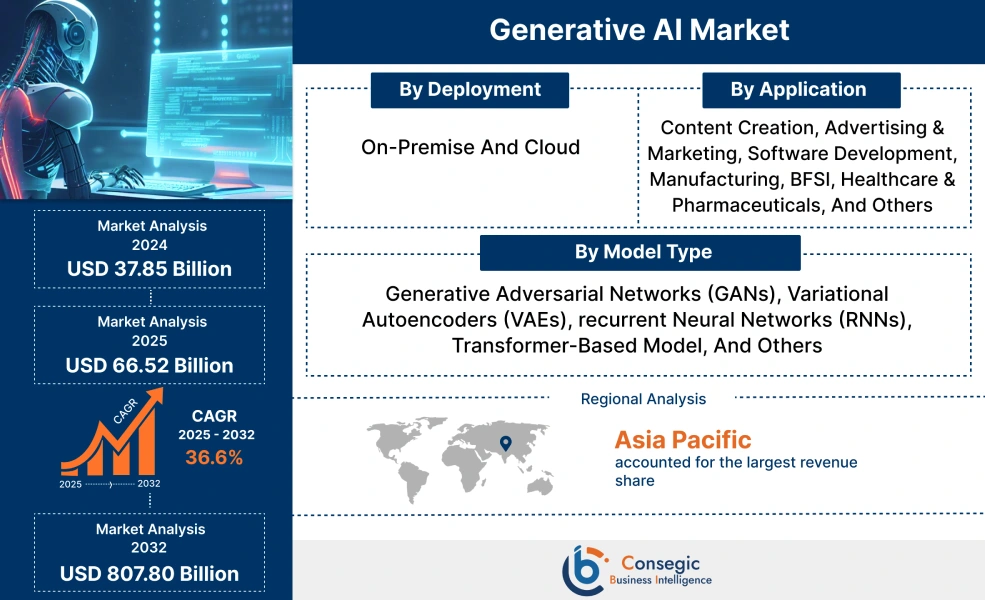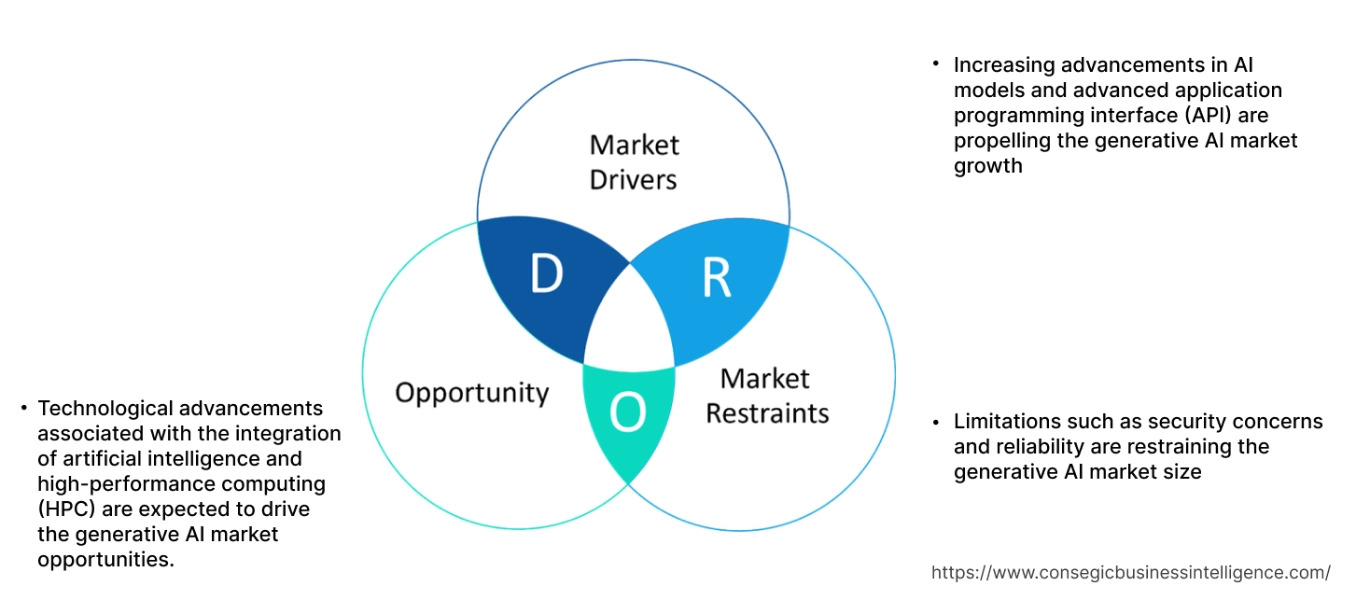Generative AI Market Size:
Generative AI Market size is estimated to reach over USD 807.80 Billion by 2032 from a value of USD 37.85 Billion in 2024 and is projected to grow by USD 66.52 Billion in 2025, growing at a CAGR of 36.6% from 2025 to 2032.
Generative AI Market Scope & Overview:
Generative AI, also known as gen AI, is a type of artificial intelligence that encompasses various models and techniques to create new data or content, including audio, code, images, text, and simulations. Gen AI handles multiple tasks like encoding a collection of existing information into a vector space and when prompted, creates new content by finding accurate context within the existing information in the vector space. Moreover, gen AI is made from several components such as a foundation model, output generation, data processing, and others. Additionally, gen AI has a wide range of applications in various industries like automotive, healthcare, sales, and marketing among others, which is further driving the global generative AI market.
Generative AI Market Dynamics - (DRO) :
Key Drivers:
Increasing advancements in AI models and advanced application programming interface (API) are propelling the generative AI market growth.
The rising adoption of gen AI is driven by the advancements in AI models and advanced APIs. Moreover, gen AI is integrated into various applications to enhance their capabilities like providing AI-powered chatbots, virtual assistance, personalized recommendations, and others, in turn leading to automation and enhanced customer experience. Additionally, advanced APIs allow businesses to easily integrate these gen AI capabilities into their systems allowing them to generate texts, images, videos, and other forms of media.
- For instance, ElevenLabs is a UK-based voice generation software company, which specializes in generating natural-sounding speech synthesis software using deep learning and gen AI.
Thus, the increasing advancements in AI models and advanced programming interfaces are propelling the generative AI market expansion.
Key Restraints:
Limitations such as security concerns and reliability are restraining the generative AI market size
Security concerns, compliance with regulatory framework, and reliability are significant challenges for organizations to deploy gen AI. Moreover, these systems store and use a large amount of sensitive and personal data, which can cause unauthorized access or data breaches.
Additionally, reliability is a significant challenge in deploying gen AI due to its inherent tendency to produce inaccurate information. Therefore, security concerns and reliability associated with the use of gen AI are hindering the generative AI market.
Future Opportunities :
Technological advancements associated with the integration of artificial intelligence and high-performance computing (HPC) are expected to drive the generative AI market opportunities.
Rapid advancements associated with gen AI due to the integration of artificial intelligence and high-performance computing are driving the market. Key factors such as the availability of massive data, higher computing infrastructure, and the development of advanced AI and techniques are expected to provide favorable growth aspects for the market. Moreover, HPC offers the necessary computational resources to train and run large complex models, including GPUs and specialized accelerators.
- For instance, Perplexity AI, is a free AI-powered answer engine that uses gen AI to provide users with instant, answers to their queries.
Therefore, the rising technological advancements associated with the integration of artificial intelligence and HPC are projected to boost the generative AI market opportunities during the forecast period.
Generative AI Market Segmental Analysis :
By Model Type:
Based on model type, the market is segmented into generative adversarial networks (GANs), variational autoencoders (VAEs), recurrent neural networks (RNNs), transformer-based model, and others.
Trends in the model type:
- There is a rising trend towards the adoption of GANs, due to rising advancements in their architectures and image generation capabilities.
- Increasing adoption of transformer-based models, due to their ability to capture long-range dependencies in sequential data, is driving the market.
The generative adversarial networks (GANs) segment accounted for the largest revenue in the overall generative AI market share in 2024.
- Generative adversarial networks are a type of machine learning model that is designed to generate new structures and instances, which resemble the training data.
- Moreover, GANs utilize two neural networks like the generator and discriminator operating in an adversarial process.
- Additionally, deep convolutional generative adversarial networks, a type of GAN, can be trained to generate realistic images from textual descriptions of various objects.
- For instance, Viso.ai utilizes GANs for various image reconstruction and computer vision tasks due to their excellent image generation capabilities.
- Hence, rising advancements associated with GANs in gen AI are driving the market growth.
The transformer-based model segment is anticipated to register a substantial CAGR growth during the forecast period.
- Transformer-based model is a type of deep learning model that uses a specific architecture named transformer to generate sequences of data like text, code, speech, and others.
- Moreover, transformer-based model type effectively handles long-range dependencies in sequential data by employing a self-attention mechanism.
- Additionally, AI systems like GPT and Lambda are built using transformer-based architecture, which enables them to process language and generate human-like text.
- Hence, increasing innovations related to transformer-based models are projected to drive the generative AI market size during the forecast period.
By Deployment:
Based on deployment, the market is segmented into on-premise and cloud.
Trends in the deployment:
- There is a rising trend towards the adoption of cloud-based gen AI due to its exceptional infrastructure management capabilities.
- Increasing trend in the adoption of on premise-based gen AI due to its higher accuracy, improved data governance, and seamless integration is driving the generative AI market growth.
On-premise segment accounted for the largest revenue in the overall market share in 2024.
- On-premise gen AI involves running AI models within an organization’s own infrastructure.
- Moreover, on-premise deployment often maintains control over data flow, model access, and security protocols, and provides a framework that adheres to legal protocols.
- Additionally, due to their customization flexibility, on-premise solutions are easy to integrate with existing legacy systems within the organizations.
- Hence, the aforementioned factors are further driving the market growth.
Cloud segment is anticipated to register the fastest CAGR growth during the forecast period.
- Cloud-based gen AI utilizes cloud computing infrastructure to power AI models like large language models for various model training tasks.
- Moreover, cloud-based gen AI often offers application programming interface accessibility, which enables developers to integrate AI functionalities without needing to manage the underlying infrastructure.
- For instance, in August 2023, Nutanix announced GPT in a box, which includes AI-ready infrastructure with integration of new solutions like software-defined Nutanix cloud platform, files and object storage, open source software like Pytorch & ML KubeFlow, and others.
- Hence, increasing innovations related to cloud-based gen AI are projected to drive the market during the forecast period.
By Application:
Based on application, the market is segmented into content creation, advertising & marketing, software development, manufacturing, BFSI, healthcare & pharmaceuticals, and others.
Trends in the application:
- Rising trend in the utilization of gen AI in BFSI industry for personalised financial advice and fraud detection and prevention is driving the market.
- Increasing trend in the adoption of gen AI in content creation, due to its enhanced content quality and the ability to personalize and scale content production is driving the generative AI market trends.
Content creation segment accounted for the largest revenue share of 32.45% in the overall generative AI market share in 2024.
- Gen AI in content creation refers to the utilization of artificial intelligence algorithms to generate basic news articles, product descriptions, scripts and reports to help content creators.
- Moreover, gen AI analyses user’s data to create personalized content experiences according to individual performance.
- For instance, Runway offers advanced AI image and video image tools for human imagination, which can be utilized by various content creators to generate content.
- Therefore, according to analysis, there is a rise in adoption of gen AI in content creation, which is further driving the generative AI market trends.
BFSI segment is anticipated to register a significant CAGR growth during the forecast period.
- Generative AI in BFSI provides efficient solutions to enhance operational efficiency and customer experiences.
- Moreover, this advanced technology processes vast amounts of data, which enables the BFSI sector to automate complex tasks by providing personalized services and reducing fraudulent activities.
- Additionally, enterprise chatbots and machine learning algorithms play a critical role in fraud detection, risk assessment, and customer service, in turn increasing customer satisfaction and retention while lowering operational expenses.
- For instance, Fluid AI, an AI company that specializes in making gen AI technology offers generative AI-powered chatbots for application in BFSI sector among others.
- Therefore, according to analysis, the rising advancements related to generative AI in BFSI sector are projected to drive the market during the forecast period.
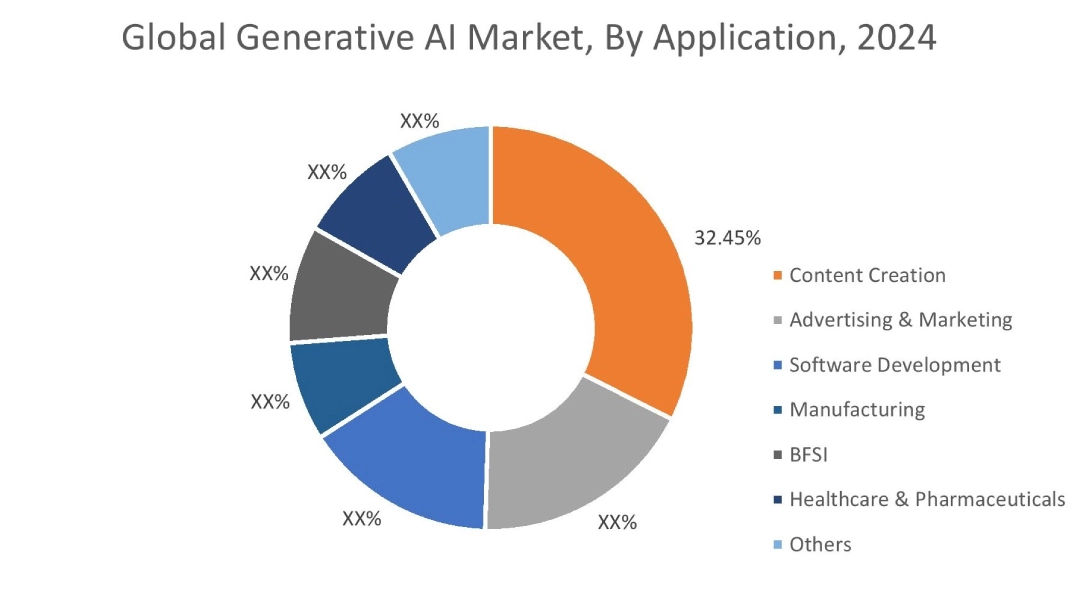
Regional Analysis:
The regions covered are North America, Europe, Asia Pacific, the Middle East and Africa, and Latin America.
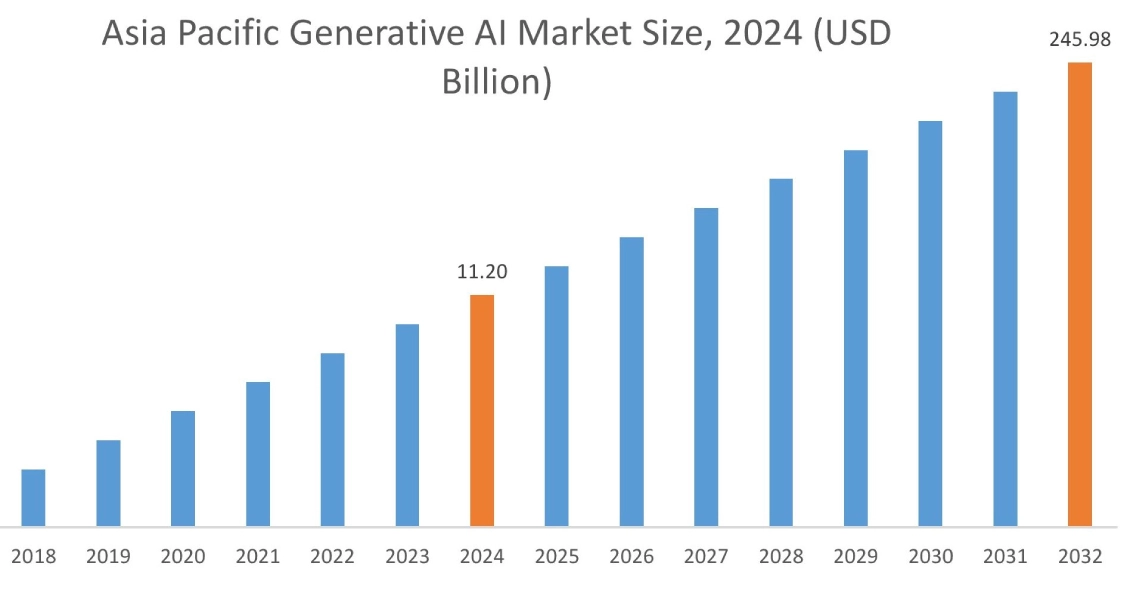
Asia Pacific region was valued at USD 11.20 Billion in 2024. Moreover, it is projected to grow by USD 19.74 Billion in 2025 and reach over USD 245.98 Billion by 2032. Out of this, China accounted for the maximum revenue share of 35.45%. As per generative AI market analysis, the adoption of gen AI in the Asia-Pacific region is primarily driven by a broad range of applications like integration of gen AI in chatbots, automated script generation in content creation, and detection of fraudulent cases in the BFSI sector. Additionally, the rising adoption of gen AI in software development, advertising, and manufacturing applications is further propelling the generative AI market expansion.
- For instance, in August 2024, Oppo showcased its advancements in Gen AI, aiming to integrate gen AI capabilities across its smartphone product lines. The above factors are boosting the market demand in Asia-Pacific region.
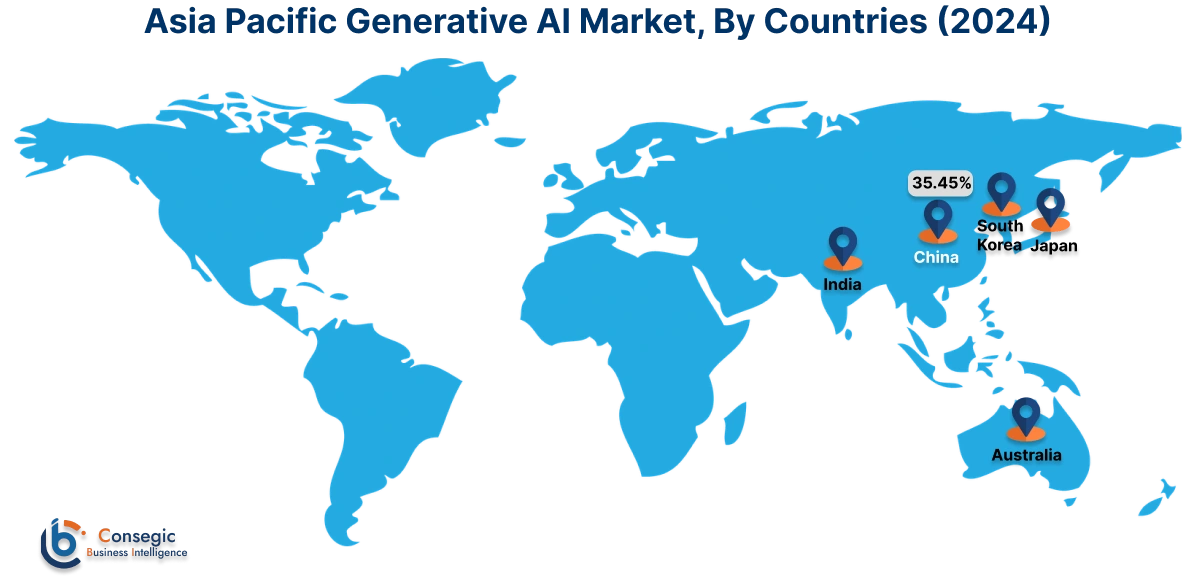
North America is estimated to reach over USD 321.50 Billion by 2032 from a value of USD 15.13 Billion in 2024 and is projected to grow by USD 26.59 Billion in 2025. In North America, the adoption of gen AI is driven in various sectors including the growing healthcare, retail, IT and telecommunication, and other sectors. Moreover, according to generative AI market analysis, the increasing integration of gen AI in healthcare and IT & telecommunication sectors, due to its ability to handle linguistic tasks and automate workflows, is contributing to the generative AI market demand.
- For instance, in October 2024, Nvidia and Accenture announced their expansion, forming a new business group to help clients rapidly scale agentic AI systems and gen AI systems.
Additionally, the regional analysis depicts that the growing adoption of gen AI, driven by a combination of factors including flexibility of operating business models, growing demand for AI-enabled products, and increasing availability of advanced computing resources are driving the generative AI market demand in Europe. Furthermore, as per the market analysis, the market demand in Latin America, Middle East, and African regions is expected to grow at a considerable rate due to factors such as increasing investments in software development, manufacturing, and healthcare sectors, along with the prevalence of high-quality data for effective training of gen AI technologies among others.
Top Key Players and Market Share Insights:
The generative AI market is highly competitive with major players providing solutions to the national and international markets. Key players are adopting several strategies in research and development (R&D), product innovation, and end-user launches to hold a strong position in the generative AI industry. Key players in the generative AI industry include-
- NVIDIA (U.S.)
- Synthesia Limited (U.K.)
- Google LLC (U.S.)
- IBM Corporation (U.S.)
- Cohere (U.S.)
- Anthropic PBC (U.S)
- Perplexity (U.S.)
- Deepseek (China)
- Microsoft (U.S.)
- OpenAI (U.S.)
Recent Industry Developments :
Product Launch:
- In May 2025, Tata Consultancy Services launched Gen AI and Agentic AI to support enterprises in modernization. Moreover, several AI technologies are integrated into TCS MasterCraft, a platform designed for application modernization.
Generative AI Market Report Insights :
| Report Attributes | Report Details |
| Study Timeline | 2019-2032 |
| Market Size in 2032 | USD 807.80 Billion |
| CAGR (2025-2032) | 36.6% |
| By Model Type |
|
| By Deployment |
|
| By Application |
|
| By Region |
|
| Key Players |
|
| North America | U.S. Canada Mexico |
| Europe | U.K. Germany France Spain Italy Russia Benelux Rest of Europe |
| APAC | China South Korea Japan India Australia ASEAN Rest of Asia-Pacific |
| Middle East and Africa | GCC Turkey South Africa Rest of MEA |
| LATAM | Brazil Argentina Chile Rest of LATAM |
| Report Coverage |
|
Key Questions Answered in the Report
How big is the generative AI market? +
The generative AI market was valued at USD 37.85 Billion in 2024 and is projected to grow to USD 807.80 Billion by 2032.
Which is the fastest-growing region in the generative AI market? +
Asia-Pacific is the region experiencing the most rapid growth in the generative AI market.
What specific segmentation details are covered in the generative AI report? +
The generative AI report includes specific segmentation details for model type, deployment, application, and region.
Who are the major players in the generative AI market? +
The key participants in the generative AI market are NVIDIA (U.S.), Synthesia Limited (U.K.), Anthropic PBC (U.S), Perplexity (U.S.), Deepseek (China), Microsoft (U.S.), OpenAI (U.S.), Google LLC (U.S.), IBM Corporation (U.S.), Cohere (U.S.) and others.
